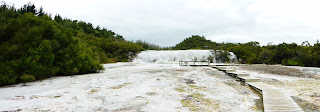After our amazing visit to Orakei Korako, we arrived in Rotorua or more correctly in Blue Lake just outside of Rotorua. Rotorua is a major geothermic centre and with that comes a very strong sulphur smell. We had been warned by locals and other travellers to stay outside the city and just go in to do what we wanted.
Rotorua planted trees from around the world in 1901 to see which trees would grow best in NZ. What happened is that they grew a rather fantastic Redwood forest with great walking trails.
That evening we attended a Maori feast and learned about their culture.
Today we spent on Whangapoua and New Chum Beach on the Coromandel Peninsula. New Chum Beach has been voted one of the 20 most beautiful beaches in the world. We needed to wait for low tide on Whangapoua Beach and then hike around a point and over the saddle to reach New Chum. It was worth it.



















































